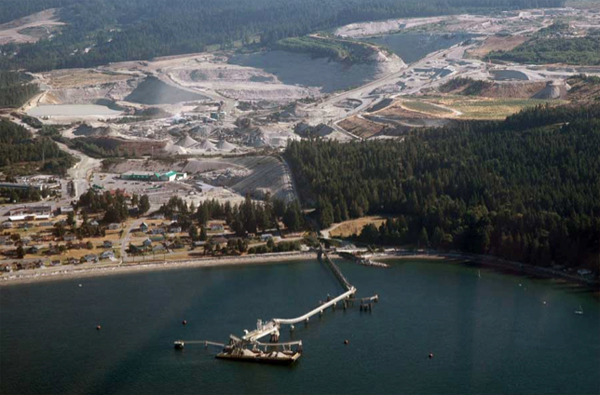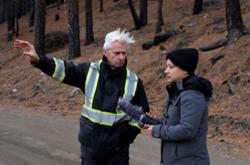[Editor's note: British Columbia's economy is growing. Much of that growth rests on expanded resource industries. Yet our laws designed to protect the unparalleled beauty and richness of the B.C. environment have been weakened, both federally and provincially, over the past decade. Over the next few weeks, this Tyee special series in cooperation with the Environmental Law Centre at the University of Victoria, will reveal what B.C.'s leading experts in environmental law say most needs to be fixed, and their specific suggestions for change. To read all their recommendations, download the free electronic publication "Maintaining Natural British Columbia for Our Children: Selected Law Reform Proposals." Today: the need for development planning.]
Change #3: It's all about the plan
By Emma Hume and Maya Stano
Mine proposals continue to spark conflict across the province. Members of the Tahltan Nation recently blockaded a road to the proposed Red Chris Mine near Dease Lake; debate rages in Fanny Bay over the proposed Raven coal mine; and concern is escalating about the scope of mining proposed across northern B.C.
The booming mining industry will likely continue to play a central role in our economy. B.C. mining laws must therefore be reformed to meet the long-term needs of local communities, respect First Nations' rights and title, and adequately protect the environment.
Today, mineral tenure laws create a two-zone "free-entry" framework that gives miners priority access to land above other important interests.
For a nominal fee, individuals with a Free Miner Certificate may explore for minerals on private and public land. The vast majority of land in B.C., with some exceptions including ecological reserves and parks, is open to exploration. Furthermore, mineral claims no longer need to be physically "staked" on the ground; they can be staked online, from anywhere in the world, on a first-come, first-serve basis.
Mineral claims holders can occupy private land for exploration and development purposes without the landowner's consent. Compensation and minimal notice are required before mining activity begins on private property, but landowners cannot refuse mining on their land. Similar rights apply on Crown land, meaning claims can be staked in areas of cultural and economic importance to First Nations, and throughout traditional territories where Aboriginal title -- which includes mineral rights -- is claimed.
Once a mineral claim is staked, the claim holder has the right to convert it to a mineral lease. This grants long-term land rights to explore and exploit minerals and raise funds for these activities. Government can't refuse to convert mineral claims to leases.
Granting these rights automatically means important considerations such as land-use plans, environmental protection and other community needs are not heard until much later in the mine development process -- when significant resources have already been invested. This process can be aggravating to the public and industry alike. It also limits use of the land for other purposes -- or setting it aside for protection -- without government having to compensate mineral rights holders for expropriation. As a result, claims staked for a few hundred dollars can result in compensation claims in the millions, a heavy burden on B.C. taxpayers.
Similarly, existing laws fail to require consultation with First Nations before mineral claims are staked, or when claims are converted into leases. This can create costly litigation over Aboriginal rights and title, and may be unconstitutional.
A recent decision by the B.C. Court of Appeal's counterpart in the Yukon raised just that issue. In Ross River Dena Council v Government of Yukon, the Court criticized free-entry as defective and held that to meet constitutional obligations the Yukon government must consult First Nations before automatically recording mineral claims and permitting exploration. Similar challenges in B.C. may require similar reform of mineral tenure laws here.
Ontario's free-entry reform
The free-entry system was developed over 100 years ago, when mining opened the "frontier" for other land uses. Partly because communication and administration were poor, miners were given priority over other land users. Since then technology, the province and our thinking have changed dramatically. Our laws must reflect these changes and balance economic, environmental and social interests while reconciling these with constitutionally protected Aboriginal rights and title.
Ontario is reforming its free-entry system. Within the last decade, prospecting in cottage country sparked outrage among private landowners. First Nations also asserted their constitutional rights. These powerful voices prompted Ontario to reform its legal system for mineral tenure, exploration and development, and private property rights. Changes include: withdrawing mining rights from some land; outlining mandatory Aboriginal consultation requirements; requiring thorough environmental rehabilitation; and creating a new system for permitting exploration activities. Meanwhile, that province continues to enjoy record levels of investment, and industry has been actively involved in the modernization process.
While Ontario's reforms are not perfect, B.C. must follow suit and begin re-writing its archaic Mineral Tenure Act and Mines Act to address the problems created by the current free-entry system. Reforms could:
• Replace "free entry" with a discretionary licensing and permitting system that requires consideration of multiple interests when allocating mineral rights. Landowners and other interested parties should have the right to petition government to withdraw lands from mineral tenure availability.
• Explicitly acknowledge Aboriginal rights and title, and require consultation with, and consent from, First Nations before claims are recorded, mining permits are granted, and mining activities begin in traditional territories.
• Establish no-go zones for mining that include land for unsettled First Nations' claims, watersheds used for drinking water, private conservation lands, sensitive lands with poor environmental restoration capability, watersheds with sensitive fisheries, adequate buffers around areas of cultural and ecological importance, and lands that link existing protected areas.
• Grant mineral tenure only in areas where land use plans have been developed and implemented. Require mines to conform to the terms of local land use plans and existing agreements with First Nations. If land use plans and agreements are not complete, any grants of mineral licenses should be made conditional on the terms of future plans and agreements.
• Require consultation with and consent from private landowners before mining activities begin. Compensation awarded to affected landowners must be fair and allow landowners to relocate if they wish.
Fix assessment process
At the same time, reforms should be made to the environmental assessment (EA) process. This includes prohibiting proponents from justifying mining activities that impair, pollute or destroy the environment on the basis of economic considerations alone. Reforms should:
• Require EAs for all mines before significant exploration activity begins, regardless of size or production capacity, with mandatory consideration of: potential impacts of early mine abandonment; cumulative impacts of adjacent, or hydraulically connected, mines; and contingency plans for unpredicted impacts, including extreme events caused by climate change.
• Establish clear legal standards to determine what adverse effects are "significant."
• Require that EA reports include non-technical summaries to promote public engagement and involvement in the review process.
• Require follow-up programs, including on-site investigations, to assess compliance with environmental obligations.
Other reforms are required for the construction, operation and reclamation stages of mine developments. Reforms could:
• Specify mandatory content for mine permit applications, including application fees adequate to cover government review costs.
• Require decision makers to take into account principles of sustainability when reviewing new permit applications and applications to amend or renew existing permits.
• Specify minimum permit requirements so that basic legal obligations for social and environmental protection are not left open to negotiation between government and the mining industry.
• Establish monitoring committees comprising members of local communities and First Nations to ensure mines comply throughout mine life with the commitments made in response to public concerns.
There should be minimum requirements for mine inspections enacted that:
• Ensure individuals conducting mine inspections are independent and not former mine employees or individuals with financial interests in the mine or mining company.
• Require adequate inspections during early mining phases, including mine construction.
• Establish minimum inspection frequencies.
• Mandate fees to adequately cover government inspection costs.
• Empower the public to request investigations of alleged regulatory violations.
We can reduce long-term impacts by:
• Eliminating the option of converting natural lakes into tailing impoundments.
• Requiring adequate security for full reclamation of all site components, including tailings impoundments.
• Ensuring that enforcement of existing laws is adequately funded.
We can reduce risks from abandoned mines by:
• Requiring operating mines to pay into an abandoned mine clean-up fund.
• Encouraging re-development of abandoned mines.
• Co-ordinating abandoned mine clean-up with land use planning.
We can support the development of a long-term mineral strategy by:
• Requiring mandatory contributions by miners to a research and development fund.
• Promoting local value-added manufacturing using mineral ore.
• Giving preference in government procurement to locally manufactured goods made from locally mined metals.
Given the growth of mineral exports from B.C., a long-term mineral strategy is needed to ensure efficient resource development and to preserve sufficient resources to meet the needs of future generations.
The adoption of these types of mining law reforms would help promote more sustainable land use in the province, while ensuring long-term benefits to British Columbians.
For more information, see:
Judah Harrison. Too Much at Stake: The Need for Mineral Tenure Reform in BC. Ecojustice.
Karen Campbell. Undermining Our Future: How Mining's Privileged Access to Land Harms People and the Environment. West Coast Environmental Law.
Maya Stano. The Raven Mine: A Regulatory & Fiscal Black Hole? A look at environmental enforcement & securities at mines in BC. Environmental Law Centre Clinic. ![]()
Read more: Labour + Industry, BC Politics, Environment

















Tyee Commenting Guidelines
Comments that violate guidelines risk being deleted, and violations may result in a temporary or permanent user ban. Maintain the spirit of good conversation to stay in the discussion.
*Please note The Tyee is not a forum for spreading misinformation about COVID-19, denying its existence or minimizing its risk to public health.
Do:
Do not: